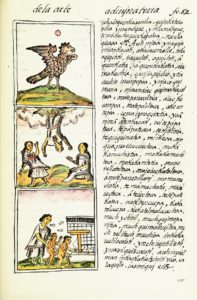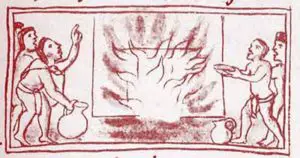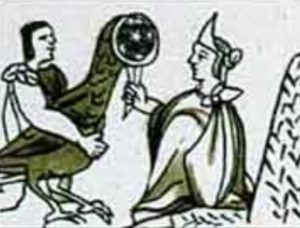Podcast: Play in new window | Download
Subscribe: Apple Podcasts | RSS
 The Spanish encountered the Aztec Empire not as a bunch of lost cities in the jungle but as a living, breathing civilization. When the conquistadors were welcomed into the Aztec capital of Tenochtitlan by the Emperor Montezuma in 1519, the Aztecs had controlled most of central Mexico by outright subjugation and through various systems of tribute. The Aztec Empire’s influence was felt as far away as Central America and the American Southwest. Many living under Aztec control wanted the empire out of their lives, and when the Spanish arrived they welcomed the Europeans who would help them overthrow the empire. Before the arrival of the Spanish the Aztecs knew their control over central Mexico was somewhat tenuous and were always aware of the possibility of internal strife causing a political and social collapse. In the days of Montezuma’s reign, at the beginning of the 16th Century and starting some ten years before the arrival of Cortés and his men, Emperor Montezuma was witness to 8 omens which supposedly foretold the end of the empire and his own death. Because of these omens there was an underlying feeling that the Aztecs were doomed, and when the Spanish arrived those who remembered the omens saw their fates as sealed. Whether or not these omens actually occurred is a question for historians and folklorists alike. We first see them mentioned in The Florentine Codex, a massive 3-volume illustrated ethnographic compilation put together by the Spanish Franciscan friar Bernardino de Sahagún. The codex has over 2,000 illustrations in its 2,400 pages and in Book 12 of the Codex we find the 8 signs that supposedly predicted the doom to befall the Aztecs. Scholars are divided as to whether or not these omens were made up after the fact to justify the Spanish Conquest in the eyes of the conquered natives and to the rest of the world, or if they really happened. Myth or real, here are the 8 omens of Montezuma in the order they occurred.
The Spanish encountered the Aztec Empire not as a bunch of lost cities in the jungle but as a living, breathing civilization. When the conquistadors were welcomed into the Aztec capital of Tenochtitlan by the Emperor Montezuma in 1519, the Aztecs had controlled most of central Mexico by outright subjugation and through various systems of tribute. The Aztec Empire’s influence was felt as far away as Central America and the American Southwest. Many living under Aztec control wanted the empire out of their lives, and when the Spanish arrived they welcomed the Europeans who would help them overthrow the empire. Before the arrival of the Spanish the Aztecs knew their control over central Mexico was somewhat tenuous and were always aware of the possibility of internal strife causing a political and social collapse. In the days of Montezuma’s reign, at the beginning of the 16th Century and starting some ten years before the arrival of Cortés and his men, Emperor Montezuma was witness to 8 omens which supposedly foretold the end of the empire and his own death. Because of these omens there was an underlying feeling that the Aztecs were doomed, and when the Spanish arrived those who remembered the omens saw their fates as sealed. Whether or not these omens actually occurred is a question for historians and folklorists alike. We first see them mentioned in The Florentine Codex, a massive 3-volume illustrated ethnographic compilation put together by the Spanish Franciscan friar Bernardino de Sahagún. The codex has over 2,000 illustrations in its 2,400 pages and in Book 12 of the Codex we find the 8 signs that supposedly predicted the doom to befall the Aztecs. Scholars are divided as to whether or not these omens were made up after the fact to justify the Spanish Conquest in the eyes of the conquered natives and to the rest of the world, or if they really happened. Myth or real, here are the 8 omens of Montezuma in the order they occurred.
 The first omen reportedly occurred a full 10 years before the arrival of the Spaniards, which would put it happening around 1509. One day what has been described as a “fire plume” appeared in the sky. According to the legends, this is commonly referred to as “the sky omen”. A great streak of light appeared in the night sky for almost a year, described as narrow at the tip and wide at its base, and so bright that it seemed like daybreak in the middle of the night. This “fire plume” was most likely a comet and is verified by an Aztec source called The Codex Telleriano–Remensis which chronicles natural disasters and cosmic events that happened in central Mexico from the 14th Century to the 16th Century. There is an illustration in this codex showing Emperor Montezuma with a comet overhead and the Aztec calendar date corresponds to the European year of 1509. So, this may be an omen that has an actual historical basis. In any event, the sky “fire plume” omen caused great distress among the people of ancient Mexico. According to one source, “As soon as it appeared, men cried out, slapping their mouths with the palms of their hands. Everybody was afraid, everybody wailed.” Comets throughout history have been seen as bringers of good luck or bad luck, and in this case, the comet was seen as a bad omen.
The first omen reportedly occurred a full 10 years before the arrival of the Spaniards, which would put it happening around 1509. One day what has been described as a “fire plume” appeared in the sky. According to the legends, this is commonly referred to as “the sky omen”. A great streak of light appeared in the night sky for almost a year, described as narrow at the tip and wide at its base, and so bright that it seemed like daybreak in the middle of the night. This “fire plume” was most likely a comet and is verified by an Aztec source called The Codex Telleriano–Remensis which chronicles natural disasters and cosmic events that happened in central Mexico from the 14th Century to the 16th Century. There is an illustration in this codex showing Emperor Montezuma with a comet overhead and the Aztec calendar date corresponds to the European year of 1509. So, this may be an omen that has an actual historical basis. In any event, the sky “fire plume” omen caused great distress among the people of ancient Mexico. According to one source, “As soon as it appeared, men cried out, slapping their mouths with the palms of their hands. Everybody was afraid, everybody wailed.” Comets throughout history have been seen as bringers of good luck or bad luck, and in this case, the comet was seen as a bad omen.
 The second omen had to do with the Aztec god Huitzilopochtli and it also involved a fire, but a more terrestrial kind. Huitzilopochtli was not only the god of war, of human sacrifice and of the sun, he was the patron and protector of the Aztec capital at Tenochtitlan and was seen as sort of a national god of the Aztecs. According to Aztec legends it was this god who was with them as a protector from Day One. From their wanderings in the desert through their conquest of most of Mexico, Huitzilopochtli was always there watching over and guiding the Aztec people. It was a national catastrophe when the temple dedicated to this god caught fire in the central ceremonial complex of the Aztec capital. First, the wooden pillars of the temple caught fire suddenly and then the fire spread to the rest of the structure. It seemed that whenever water was poured on the fire, the fire increased. When the fire was finally extinguished with most of Huitzilopochtli’s temple gone, the Aztec priests and astrologers declared what the citizens of the great city had already felt: this was a very bad omen.
The second omen had to do with the Aztec god Huitzilopochtli and it also involved a fire, but a more terrestrial kind. Huitzilopochtli was not only the god of war, of human sacrifice and of the sun, he was the patron and protector of the Aztec capital at Tenochtitlan and was seen as sort of a national god of the Aztecs. According to Aztec legends it was this god who was with them as a protector from Day One. From their wanderings in the desert through their conquest of most of Mexico, Huitzilopochtli was always there watching over and guiding the Aztec people. It was a national catastrophe when the temple dedicated to this god caught fire in the central ceremonial complex of the Aztec capital. First, the wooden pillars of the temple caught fire suddenly and then the fire spread to the rest of the structure. It seemed that whenever water was poured on the fire, the fire increased. When the fire was finally extinguished with most of Huitzilopochtli’s temple gone, the Aztec priests and astrologers declared what the citizens of the great city had already felt: this was a very bad omen.
The third omen occurred at another sacred place, a building used as both a temple and a monastery called Tzommolco-calmecac, also located in the central part of the Aztec capital of Tenochtitlan. The temple-monastery complex was dedicated to the god Xiuhtecuhtli. This god was symbolized by the North Star and was seen as the lord of fire, patron and keeper of the Mexican volcanoes and god of the daytime and of heat. Xiuhtecuhtli was also the god of food during famine, warmth during cold and of life after death. He lived in an impenetrable enclosure made of turquoise located somewhere underneath the earth so that no harm would come to him. The temple at Tzommolco was not as strong as this turquoise enclosure. On a day of misty drizzle, a bolt of lightning came down and struck the temple and its thatched roof caught fire immediately. Witnesses claimed that there was no sound of thunder accompanying the lightning strike and that the storm was not a severe one. It seemed to occur for no reason, other than to be a “bad sign.”
The fourth omen happened much like the first, overhead in the skies. Thousands of people throughout central Mexico looked to the skies bewildered and afraid when they saw three large balls of fire emitting sparks streak across the sky from west to east. Some reported a terrible sound accompanying this spectacle, like a deep roar of a wild animal. Later it was determined that these were most likely meteors entering the earth’s atmosphere and heading for somewhere in the Gulf of Mexico. Nevertheless, this heavenly phenomenon was interpreted by all who saw it as a bad sign.
 The fifth omen had to do with the lifeblood and the highway of the Aztecs, the very lake on which their capital sat, Lake Texcoco. Fishing boats were out on the water normally one day in calm weather when suddenly the lake welled up. Swirling eddies tossed about the boats and caused a mini tidal wave to hit the settlements on the shore, including the capital city which was on the island in the middle of the lake. Many buildings flooded and some structures crumbled. While not too disastrous, this event had a more devastating psychological effect. No one could explain why the water in the lake would do that and it was another one to put on the list of the bad omens that were foretelling the great disaster that was to come. Modern day scientists and researchers theorize that seismic or underground volcanic activity could have been responsible for the strange behavior of Lake Texcoco that day.
The fifth omen had to do with the lifeblood and the highway of the Aztecs, the very lake on which their capital sat, Lake Texcoco. Fishing boats were out on the water normally one day in calm weather when suddenly the lake welled up. Swirling eddies tossed about the boats and caused a mini tidal wave to hit the settlements on the shore, including the capital city which was on the island in the middle of the lake. Many buildings flooded and some structures crumbled. While not too disastrous, this event had a more devastating psychological effect. No one could explain why the water in the lake would do that and it was another one to put on the list of the bad omens that were foretelling the great disaster that was to come. Modern day scientists and researchers theorize that seismic or underground volcanic activity could have been responsible for the strange behavior of Lake Texcoco that day.
The sixth omen concerns the sounds of a weeping woman which some say may be the basis of the legend of La Llorona. Please see Mexico Unexplained episode Number Three for a detailed description of the Llorona legend. For several nights the citizens of the Aztec capital city had heard the cries of a woman. Some believed that it was the snake-skirted goddess Coatlicue, the mother deity of all the Aztecs, warning her children of the disasters yet to come. On some evenings the female voice was heard to be saying, “My children, it is already too late,” and “My children, where can I take you?” The haunting voice filled all who heard it with a deep sense of dread and news of what was happening quickly spread from the capital city to all the corners of the Aztec Empire. What was behind this wailing woman’s message of foreboding? What did it mean?
 The seventh omen had to do with a strange bird found by fisherman on Lake Texcoco. When the men saw this unusual gray-colored bird, they captured it in their nets and brought it directly to the imperial palace to present it to Emperor Montezuma, who had an impressive private zoo and collected strange and interesting creatures. Please see Mexico Unexplained episode number 43 for a detailed discussion about Montezuma’s private zoo. In his vast collection of animals, the Aztec emperor had never seen such an unusual bird. It appeared to be some sort of crane, but it had a flat, round, black reflective surface on its forehead, almost like a mirror. When he looked at the mirror-like fixture on the bird’s head, Montezuma could see the sky and the constellations and then people came into view. He saw a great army with men riding gigantic deer and carrying weapons unknown to him. When Montezuma called the court priests and astrologers over to see the images in the mirror, the images vanished and the bird died.
The seventh omen had to do with a strange bird found by fisherman on Lake Texcoco. When the men saw this unusual gray-colored bird, they captured it in their nets and brought it directly to the imperial palace to present it to Emperor Montezuma, who had an impressive private zoo and collected strange and interesting creatures. Please see Mexico Unexplained episode number 43 for a detailed discussion about Montezuma’s private zoo. In his vast collection of animals, the Aztec emperor had never seen such an unusual bird. It appeared to be some sort of crane, but it had a flat, round, black reflective surface on its forehead, almost like a mirror. When he looked at the mirror-like fixture on the bird’s head, Montezuma could see the sky and the constellations and then people came into view. He saw a great army with men riding gigantic deer and carrying weapons unknown to him. When Montezuma called the court priests and astrologers over to see the images in the mirror, the images vanished and the bird died.
The last omen occurred just weeks before the Spanish arrived at the Aztec capital. A two-headed man appeared in the streets of Tenochtitlan. Witnesses were alarmed at the sight and people knew that the emperor had a human section of his zoo where he housed people with various deformities, so the two-headed man was brought directly to Montezuma. According to the legend, when the emperor laid eyes on him, the two-headed man just disappeared. Another variation of this omen has a number of two-headed men showing up in the streets of the Aztec capital and all of them vanishing when brought to the imperial palace. As it was known that Montezuma took a keen interest in such people, this omen may have some basis in historical fact.
According to the legends, Montezuma did not dismiss the omens but meditated on them and took them very seriously. In spite of having the best astrological and priestly counsel in the Aztec Empire, the emperor had no idea of what the omens meant or what fate would befall him or his realm. As news of the omens spread throughout the empire, perhaps some people were psychologically prepared for what was to come. Given the brutality experienced by some of the peoples subjugated by the Aztecs, perhaps each omen represented hope instead of doom. Whether good or bad, all who had heard of these omens had a feeling that big changes were on the horizon and they were right.
REFERENCES (This is not a formal bibliography)
Latin American Folktales by John Bierhorst
Various online sources

One thought on “The 8 Omens of Montezuma and the End of the Aztec Empire”
Loved this write up! Thank you